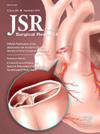When Is Diversion Indicated After Right-Sided Colon Resections?
IF 1.8
3区 医学
Q2 SURGERY
引用次数: 0
Abstract
Introduction
Ileocolonic anastomoses have a low anastomotic leak (AL) risk, resulting in infrequent diverting loop ileostomy use. Identifying patients who warrant diverting loop ileostomy with right-sided resection is challenging due to this low incidence of AL. Therefore, a multicenter database was used to develop an AL risk score to help inform when diversion should be strongly considered after right-sided resections.
Materials and methods
Patients undergoing elective right-sided resections within the 2012-2020 American College of Surgeons National Surgical Quality Improvement Program-targeted colectomy participant user files were identified. Multivariable logistic regression identified AL risk factors that were then converted to point values to develop an AL risk score. The developed AL risk score was then assessed for visual correspondence and analyzed for internal validity.
Results
42,176 patients underwent right-sided resection without diversion, and the incidence of AL was 2.4%. The risk calculator exhibited excellent calibration and fair discrimination. Strong visual correspondence was observed for predicted and actual AL rates within the 95% confidence interval for nine of ten risk score deciles.
Conclusions
An internally validated AL risk score for elective ileocolic resections was developed. Most patients had scores that categorized them at a low risk of AL. The diversion after elective right-sided resections should be reserved for extreme cases.
右侧结肠切除术后何时需要转流?
导言回结肠吻合术的吻合口漏(AL)风险很低,因此很少使用分流回肠造口术。由于AL发生率较低,因此鉴别哪些患者需要进行右侧切除的憩室回肠造口术具有挑战性。因此,研究人员利用多中心数据库制定了 AL 风险评分,以帮助确定右侧切除术后何时应强烈考虑转流。材料和方法在 2012-2020 年美国外科学院国家外科质量改进计划目标结肠切除术参与者用户档案中,对接受选择性右侧切除术的患者进行了鉴定。多变量逻辑回归确定了AL风险因素,然后将这些因素转换成点值,得出AL风险评分。结果42176名患者接受了无转流的右侧切除术,AL发生率为2.4%。风险计算器显示出良好的校准性和公平的区分度。在 10 个风险评分十分位数中,有 9 个十分位数的预测 AL 发生率和实际 AL 发生率在 95% 置信区间内有很强的视觉对应性。大多数患者的评分将其归类为低 AL 风险。选择性右侧切除术后的转流应保留给极端病例。
本文章由计算机程序翻译,如有差异,请以英文原文为准。
求助全文
约1分钟内获得全文
求助全文
来源期刊
CiteScore
3.90
自引率
4.50%
发文量
627
审稿时长
138 days
期刊介绍:
The Journal of Surgical Research: Clinical and Laboratory Investigation publishes original articles concerned with clinical and laboratory investigations relevant to surgical practice and teaching. The journal emphasizes reports of clinical investigations or fundamental research bearing directly on surgical management that will be of general interest to a broad range of surgeons and surgical researchers. The articles presented need not have been the products of surgeons or of surgical laboratories.
The Journal of Surgical Research also features review articles and special articles relating to educational, research, or social issues of interest to the academic surgical community.

 求助内容:
求助内容: 应助结果提醒方式:
应助结果提醒方式:


